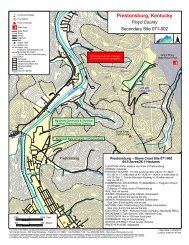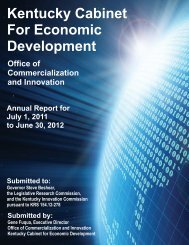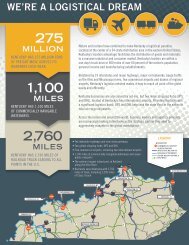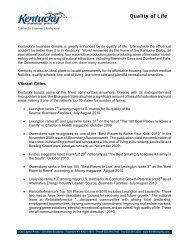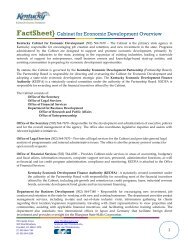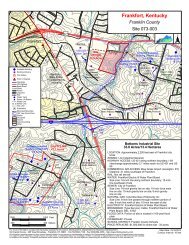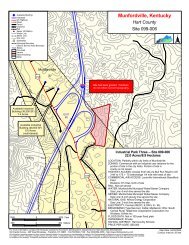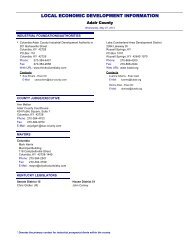TIF - Kentucky Cabinet for Economic Development
TIF - Kentucky Cabinet for Economic Development
TIF - Kentucky Cabinet for Economic Development
Create successful ePaper yourself
Turn your PDF publications into a flip-book with our unique Google optimized e-Paper software.
<strong>Kentucky</strong> <strong>Economic</strong> <strong>Development</strong> Finance<br />
Authority (KEDFA)<br />
Tax Increment Financing (<strong>TIF</strong>)<br />
This fact sheet provides an overview of the <strong>TIF</strong> program. For a full discussion of the program<br />
requirements, please see KRS Chapter 65 and 154. As with all state administered incentive<br />
programs, any inducements offered under the <strong>TIF</strong> program are negotiated by <strong>Cabinet</strong> <strong>for</strong> <strong>Economic</strong><br />
<strong>Development</strong> officials and presented as a recommendation to the <strong>Kentucky</strong> <strong>Economic</strong><br />
<strong>Development</strong> Finance Authority <strong>for</strong> approval.<br />
Overview<br />
Tax Increment Financing (<strong>TIF</strong>) is a tool to use future gains in taxes to finance the current improvements that<br />
will create those gains. When a public project is carried out, there is an increase in the value of surrounding real<br />
estate, and often new investment (new or rehabilitated buildings, <strong>for</strong> example). This increased site value and<br />
investment creates increases in values of taxable properties and taxable activities, which increases tax revenues.<br />
The increased tax revenues are the "tax increment." Tax Increment Financing dedicates that increased revenue to<br />
finance debt issued to pay <strong>for</strong> the public infrastructure of the project. <strong>TIF</strong> is designed to channel funding toward<br />
the public improvements in distressed or underdeveloped areas where development would not otherwise occur.<br />
<strong>TIF</strong> creates funding <strong>for</strong> public projects that may otherwise be unaf<strong>for</strong>dable to localities.<br />
The first step <strong>for</strong> all programs is the establishment of a <strong>TIF</strong> development area by a city, a county, or one of the<br />
eligible agencies identified in statute as eligible. The statutes authorize two types of <strong>TIF</strong> development areas. A<br />
development area on vacant land is eligible <strong>for</strong> local participation only. A development area which includes a<br />
developed area in need of redevelopment or other blight conditions may be eligible <strong>for</strong> both state and local<br />
participation. There are three separate state participation programs available, each of which has its own distinct<br />
requirements <strong>for</strong> eligibility.<br />
Local <strong>Development</strong> Areas<br />
There are two types of local tax development areas that can be established. Statute provides detailed<br />
requirements <strong>for</strong> the establishment of a development area, including public hearing requirements, ordinance<br />
requirements, and parameters <strong>for</strong> agreements establishing the development area and pledging financial support.<br />
Support at the local level can be provided through the entire development area, or on a project by project basis.<br />
The Three types of local development areas are as follows:<br />
Local Only <strong>Development</strong> Areas – The local only <strong>TIF</strong> development area may be established by a local<br />
government or eligible agency on vacant land. The local government may pledge up to 100 percent of<br />
incremental property taxes and occupational license taxes or fees <strong>for</strong> up to 20 years.<br />
All local only development areas are subject to the following conditions:<br />
• The land must be a previously undeveloped tract of land;<br />
• The maximum size cannot exceed 1,000 acres in a calendar year; and<br />
• The total amount of property within a city or county that may be in a <strong>TIF</strong> development area cannot<br />
exceed 20 percent of the total value of taxable real property within the jurisdiction(s) establishing the<br />
<strong>TIF</strong> development area.<br />
Blighted Urban Redevelopment Areas – These development areas may be established by a local government or<br />
eligible agency in an area that meets two of seven specified blight/deterioration conditions established in KRS<br />
65.7049(3), such as abandonment or deterioration of structures, presence of environmentally contaminated land,<br />
and inadequate or deteriorating public infrastructure. The local government may pledge up to 100 percent of<br />
incremental property taxes and occupational license taxes or fees <strong>for</strong> up to 30 years. Projects in this type of<br />
development area are eligible <strong>for</strong> state participation if they meet certain requirements.<br />
Old Capitol Annex · 300 West Broadway · Frank<strong>for</strong>t, KY 40601-1975 · Phone 502.564.7140 · Fax 502.564.3256 · www.thinkkentucky.com
<strong>Kentucky</strong> <strong>Economic</strong> <strong>Development</strong> Finance<br />
Authority (KEDFA)<br />
Tax Increment Financing (<strong>TIF</strong>)<br />
All blighted urban redevelopment areas are subject to the following conditions:<br />
• The maximum size cannot exceed three square miles; and<br />
• The total amount of property within a city or county that may be in a <strong>TIF</strong> development area cannot<br />
exceed 20 percent of the total value of taxable real property within the jurisdiction(s) establishing the<br />
<strong>TIF</strong> development area.<br />
Vacant Land with 5,000 Seat Arena – <strong>Development</strong> areas may be established by a local government or eligible<br />
agency in an area of vacant land if the development contains an arena. The arena must be a facility <strong>for</strong> athletic<br />
events, live entertainment, and other per<strong>for</strong>mances, and which has a permanent seating capacity of at least 5,000.<br />
These development areas may be established by a local government or eligible agency in an area that meets two<br />
of seven specified blight/deterioration conditions established in KRS 65.7049(3), such as abandonment or<br />
deterioration of structures, presence of environmentally contaminated land, and inadequate or deteriorating<br />
public infrastructure. The local government may pledge up to 100 percent of incremental property taxes and<br />
occupational license taxes or fees <strong>for</strong> up to 30 years. Projects in this type of development area are eligible <strong>for</strong><br />
state participation if they meet certain requirements.<br />
All vacant land with 5,000 seat arena development areas are subject to the following conditions:<br />
• The maximum size cannot exceed three square miles; and<br />
• The total amount of property within a city or county that may be in a <strong>TIF</strong> development area cannot<br />
exceed 20 percent of the total value of taxable real property within the jurisdiction(s) establishing the<br />
<strong>TIF</strong> development area.<br />
State Participation Programs<br />
There are three state participation programs available. State participation is limited to a specific project within a<br />
blighted urban redevelopment or vacant land with 5,000 seat arena development area. Only the tax revenues<br />
generated within the footprint of the specific identified project are included in the increment. The footprint is<br />
defined as the actual perimeter of a discreet, identified project within a development area within which capital<br />
investments are made.<br />
Commonwealth Participation Program <strong>for</strong> Real Property Ad Valorem Tax Revenues<br />
• The project must represent net positive impact in the Commonwealth as certified by a qualified<br />
independent outside consultant on contract with CED;<br />
• The minimum capital investment is $10 million;<br />
• Not more than 20 percent of the approved project costs or 20 percent of the finished square footage shall<br />
be devoted to retail;<br />
• Up to 100 percent of the state real property incremental tax revenue may be pledged from the footprint<br />
of the project;<br />
• The amount of state revenues pledged shall not exceed 100 percent of approved public infrastructure<br />
costs; and<br />
• Amounts can be pledged <strong>for</strong> a maximum of 20 years.<br />
Commonwealth Participation Program <strong>for</strong> Signature Projects<br />
• Requires a minimum capital investment of $200,000,000;<br />
• Not more than 20 percent of the approved project costs or 20 percent of the finished square footage shall<br />
be devoted to retail;<br />
Old Capitol Annex · 300 West Broadway · Frank<strong>for</strong>t, KY 40601-1975 · Phone 502.564.7140 · Fax 502.564.3256 · www.thinkkentucky.com
<strong>Kentucky</strong> <strong>Economic</strong> <strong>Development</strong> Finance<br />
Authority (KEDFA)<br />
Tax Increment Financing (<strong>TIF</strong>)<br />
• The project must result in a net positive economic impact to the Commonwealth, as certified by the<br />
consultant’s report;<br />
• State taxes that may be pledged include real property ad valorem taxes, individual and corporate income<br />
taxes, the limited liability entity tax, and sales taxes;<br />
• Up to 80 percent of incremental state revenues may be pledged from the footprint of the project;<br />
• May recover up to 100 percent of approved public infrastructure costs less sales taxes paid, signature<br />
project costs less sales taxes paid, and financing costs related to public infrastructure costs over a period<br />
of up to 30 years;<br />
• Qualifies <strong>for</strong> a sales tax refund on the purchase of construction materials that do not qualify as an<br />
approved public infrastructure cost or an approved signature project cost.<br />
Commonwealth Participation Program <strong>for</strong> Mixed Use Redevelopment in Blighted Urban Areas<br />
• Defines mixed use as including at least two of the following: retail, residential, office, restaurant, or<br />
hospitality – to qualify as a use, the use must comprise at least 20 percent of the total finished square<br />
footage or 20 percent of the total capital investment. In addition the area cannot include any retail<br />
establishment that exceeds twenty thousand (20,000) square feet of finished square footage.<br />
• To qualify a project must:<br />
o Be located in an area with at least three of the following blight/deterioration conditions;<br />
• Substantial loss of residential, commercial, or industrial activity or use;<br />
• Forty percent (40%) or more of the households are low-income households;<br />
• More than fifty percent (50%) of residential, commercial, or industrial<br />
structures are deteriorating or deteriorated;<br />
• Substantial abandonment of residential, commercial, or industrial structures;<br />
• Substantial presence of environmentally contaminated land;<br />
• Inadequate public improvements or substantial deterioration in public<br />
infrastructure; or<br />
• Any combination of factors that substantially impairs or arrests the growth and<br />
economic development of the city or county; impedes the provision of<br />
adequate housing; impedes the development of commercial or industrial<br />
property; or adversely affects public health, safety, or general welfare due to the<br />
development area's present condition and use.<br />
o Be a mixed use project;<br />
o Represent new economic activity in the Commonwealth;<br />
o Result in a minimum capital investment of at least $20 million but not over $200 million; and<br />
o<br />
o<br />
Result in a net positive impact to the Commonwealth.<br />
May recover up to 100 percent of approved public infrastructure costs, and costs related to land<br />
preparation, demolition and clearance over up to 20 years.<br />
Process<br />
• After establishing local <strong>TIF</strong> development area by local ordinance, local agency submits <strong>TIF</strong> application <strong>for</strong> state<br />
increments to CED.<br />
• CED staff reviews <strong>TIF</strong> application <strong>for</strong> completeness and evaluate whether, based solely on in<strong>for</strong>mation submitted by<br />
the applicant, the project is likely to meet the minimum requirements <strong>for</strong> the program.<br />
• CED staff presents <strong>TIF</strong> project to KEDFA board <strong>for</strong> preliminary approval.<br />
• Upon KEDFA preliminary approval, CED staff works with Department of Revenue and the Office of State Budget<br />
Director to develop criteria <strong>for</strong> <strong>TIF</strong> consultant’s report.<br />
• Consultant researches potential <strong>TIF</strong> project and projections submitted by local agency and determines if the<br />
projections are accurate and if the project results in a net positive impact <strong>for</strong> the commonwealth.<br />
Old Capitol Annex · 300 West Broadway · Frank<strong>for</strong>t, KY 40601-1975 · Phone 502.564.7140 · Fax 502.564.3256 · www.thinkkentucky.com
<strong>Kentucky</strong> <strong>Economic</strong> <strong>Development</strong> Finance<br />
Authority (KEDFA)<br />
Tax Increment Financing (<strong>TIF</strong>)<br />
• If the consultant’s report reflects a net positive impact to the commonwealth, CED staff negotiates the <strong>TIF</strong> available<br />
to the project and drafts a grant agreement detailing the specific taxes, amounts of increments available, and<br />
infrastructure expenditures along with reporting requirements.<br />
• CED staff presents the <strong>TIF</strong> project to KEDFA Board <strong>for</strong> final approval.<br />
• Upon final approval, the <strong>TIF</strong> project can activate and increments can begin to accrue.<br />
For further in<strong>for</strong>mation contact:<br />
Brad Thomas<br />
<strong>Kentucky</strong> <strong>Cabinet</strong> <strong>for</strong> <strong>Economic</strong> <strong>Development</strong><br />
Department of Financial Incentives<br />
Old Capitol Annex<br />
300 West Broadway 300 West Broadway<br />
Frank<strong>for</strong>t, <strong>Kentucky</strong> 40601 Frank<strong>for</strong>t, <strong>Kentucky</strong> 40601<br />
(502) 564-4554 (502) 564-4554<br />
brad.thomas@ky.gov<br />
chuck.willis@ky.gov<br />
Chuck Willis<br />
<strong>Kentucky</strong> <strong>Cabinet</strong> <strong>for</strong> <strong>Economic</strong> <strong>Development</strong><br />
Department of Financial Incentives<br />
Old Capitol Annex<br />
Revised October 29, 2009<br />
Old Capitol Annex · 300 West Broadway · Frank<strong>for</strong>t, KY 40601-1975 · Phone 502.564.7140 · Fax 502.564.3256 · www.thinkkentucky.com



